Areas: Dai (台) and Kobukuroya (小袋谷)
Place Name
The word "dai" means "a plateau or tableland." In ancient times when people made their homes so as to live in safety, one of their ideal places was a tableland with a mountain or hill behind and the sea or a river in front. The Dai area was once such a place, with hills behind and a river running at the foot.The character 岱, pronounced "dai," was often used for such a place. This custom held good here, but over the years the character was replaced by "台," which has the same pronunciation and a similar meaning. It is presumed that the character was already in use prior to the Eiroku era (永禄, 1558-70), because it has been found in a document from that era.
In olden days, the "Kobukuro" in Kobukoroya was written "巨福礼" or "小福礼." However, the present characters, "小袋," were already being used in the Warring States period (1467-1590).
| Koshoji Temple (光照寺) |
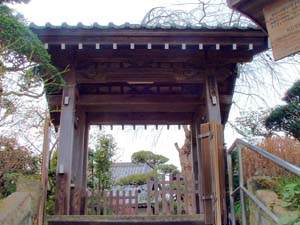
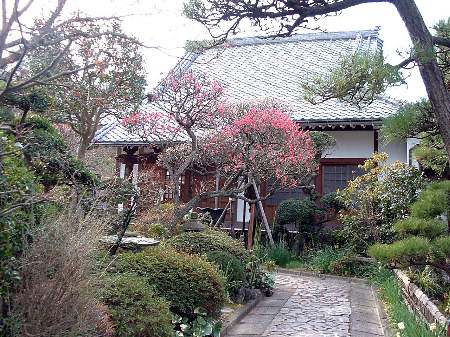
Full name: Seitaisan (西台山) Koshoji
Denomination: Ji sect (時宗)
Location: To reach Koshoji Temple, walk north some 400 meters from Kita-Kamakura Station, and turn to the left immediately after the Osaka Post Office (小坂郵便局) on the left hand side. Another 150-meter walk will bring you to the temple, on raised ground to the right.
History: The temple was founded by Ikko. This priest was a disciple of Ippen (一遍, 1239-89), who initiated the Ji sect (時宗), a form of Pure Land Buddhism. Ippen's teachings were based on the concept of tariki (他力), literally, "the power of the other—Amida," which means rebirth in the Pure Land through complete reliance on the grace of Amida.
While Honen and Shinran (親鸞,1173-1262), the founders of the Jodo sect (浄土宗, the Pure Land sect) and the Jodo Shin sect (浄土真宗, the True Pure Land sect), respectively, believed that Amida was the absolute being far above human beings, Ippen taught that Buddha and human beings were one. Ippen and his followers wandered about the country exhorting people to recite the nembutsu (念仏), the repeated chanting of "Namu Amidabutsu (南無阿弥陀仏)." Soon, wherever Ippen went, enthusiastic followers there began to perform an ecstatic nembutsu dance. Yugyoji Temple (遊行寺) in Fujisawa is the head temple of the Ji sect.
Another story says that the temple was built to commemorate the place where Ippen stayed one night after he tried to enter Kamakura and was rejected by government officials.
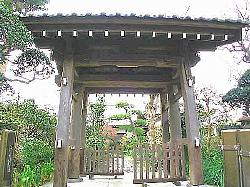
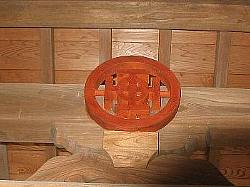
Grounds: At the top of the stone steps is the Sammon Gate (山門), popularly called Kurusumon (くるす門). The gate is unusual in that it has a crest with a stylized cross within a circle.
The temple has no connection with Christianity, as only the gate itself was transferred here in the early Meiji period (1867-1912). The crest, however, along with two candlesticks in the Main Hall that were used by Christians, attest to the presence of Christians in the area during the Edo period (1603-1867).
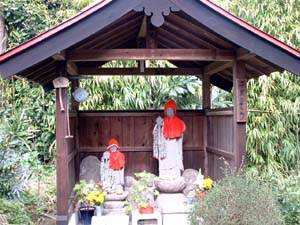
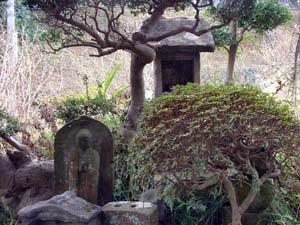
A Jizo statue, called Kosodate Jizo (子育て地蔵), literally, "Child-Rearing Jizo" stands to the right in front of the gate. It is popular among the local residents because it is believed that any kind of prayer for one's children is sure to be answered. Behind the gate and to the left is a small stone shrine, called Oshabuki (おしゃぶき).
People here believe that daily visits to the shrine will cure them of a chronic cough. The Main Hall houses many Buddhist statues: Amida Nyorai (阿弥陀如来), probably made before 1429 because the time of the repair work was recorded; two attendants, Kannon Bosatsu (観音菩薩) and Seishi Bosatsu (勢至菩薩), made in the Muromachi period (1336-1573); Shaka Nyorai (釈迦如来), transferred from Tokeiin (東渓院); Higiri Jizo (日限地蔵), "Time-Limiting Jizo," made in the Muromachi period; a seated Yakushi Nyorai (薬師如来); and a standing statue of Ikko (一向).
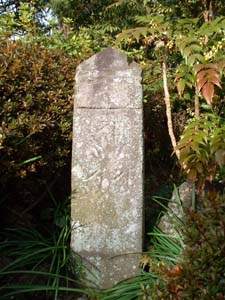 In front of the
Main Hall is an itabi-type (板碑) stone monument 60 centimeters high. It
bears the inscription 正中二年 (corresponding to 1325) and a Sanskrit
character that symbolizes three Buddhas: Amida Nyorai, Kannon Bosatsu and
Seishi Bosatsu. It is very old and precious for a monument of this kind in
Kanagawa Prefecture.
In front of the
Main Hall is an itabi-type (板碑) stone monument 60 centimeters high. It
bears the inscription 正中二年 (corresponding to 1325) and a Sanskrit
character that symbolizes three Buddhas: Amida Nyorai, Kannon Bosatsu and
Seishi Bosatsu. It is very old and precious for a monument of this kind in
Kanagawa Prefecture.
| Jofukuji Temple (成福寺) |
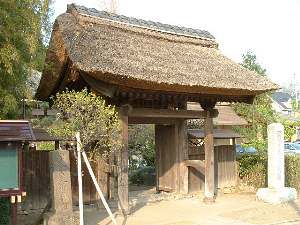
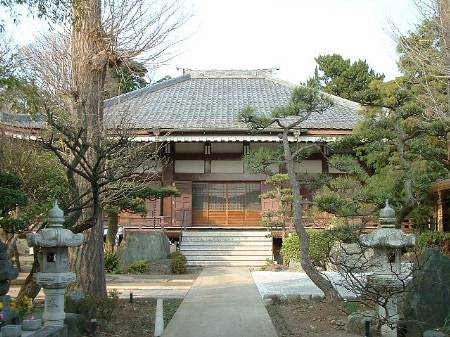
Full name: Kikkosan (亀甲山) Jofukuji
Denomination: Tendai sect (天台宗)
Location: The temple, situated some 800 meters north from Kita-Kamakura Station, is just beyond the Yokosuka Line railroad crossing to the right, and is some 150 meters north of the Suisekibashi Bridge (水堰橋), which spans the Kobukuroya-gawa River (小袋谷川).
History: The founder was a priest called Jobutsu (成仏). Temple records reveal he was the son of Hojo Yasutoki (北条泰時, 1183-1242), the third regent, and had studied Buddhism from boyhood. When he became a monk and took the name Yasutsugu Nyudo (泰次入道), he would practice asceticism in a cave called Kame no Iwaya (亀の窟) in the hill back of the temple.
 It so happened that it was during this time his
father, Yasutoki, invited some celebrated priests to study sutras at
Tsurugaoka Hachimangu Shrine. (In olden days Buddhism and Shintoism
coexisted within the same precincts.) Among them was Shinran, the priest
who founded the Jodo Shin sect, the "True Pure
Land."
It so happened that it was during this time his
father, Yasutoki, invited some celebrated priests to study sutras at
Tsurugaoka Hachimangu Shrine. (In olden days Buddhism and Shintoism
coexisted within the same precincts.) Among them was Shinran, the priest
who founded the Jodo Shin sect, the "True Pure
Land."Yasutsugu Nyudo asked Shinran for instruction and Shinran himself visited here on his way to Hachimangu. Yasutsugu thus became a disciple of Shinran and was given a new name, Jobutsu. In 1232, he converted the temple to one of the Jodo Shin sect.
Grounds: The Main Hall houses several statues: Amida Nyorai, and Shotoku Taishi (聖徳太子, 574-622). Paintings of Shinran and Rennyo (蓮如, 1415-99) are also seen there. In the Kuri, priest's living quarters, is a one-meter-high wooden statue of Kokuzo Bosatsu (虚空蔵菩薩).
A large juniper two meters in circumference stands in the courtyard. The cave, Kame no Iwaya, where Yasutsugu Nyudo practiced asceticism, still remains in the hillside.
| Itsukushima Jinja Shrine (厳島神社) |
Location: Itsukushima Jinja Shrine is located on a hillside called Kamenokoyama (亀甲山), behind Jofukuji Temple.
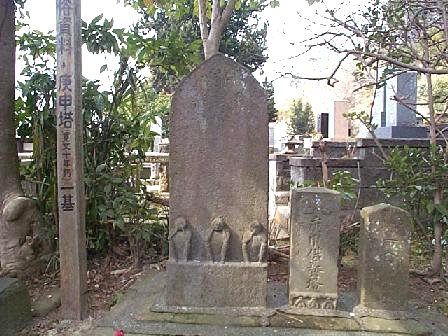 Grounds: At the foot of the torii
(鳥居) gate on the way to the shrine is a koshinto-type (庚申塔) stone
monument, engraved with three monkeys, one covering its eyes, another its
ears and the third its mouth, to symbolize the old teaching: "See no evil,
hear no evil, speak no evil." The inscription reads 寛文十年 (corresponding to
1670), marking the monument one of the oldest in Kamakura.
Grounds: At the foot of the torii
(鳥居) gate on the way to the shrine is a koshinto-type (庚申塔) stone
monument, engraved with three monkeys, one covering its eyes, another its
ears and the third its mouth, to symbolize the old teaching: "See no evil,
hear no evil, speak no evil." The inscription reads 寛文十年 (corresponding to
1670), marking the monument one of the oldest in Kamakura.
| Hachiman Jinja Shrine (八幡神社) |
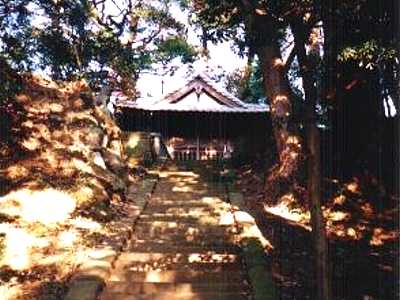
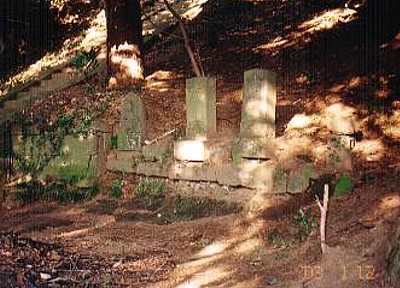
Location & Grounds: The shrine is on the hillside between Jofukuji Temple and Kita-Kamakura Station. It is popularly called Ko-Hachiman, literally, "Minor Hachiman," by the local inhabitants.
On the right halfway up the stone stairway leading to the shrine are koshinto-type stone monuments. One is engraved with three monkeys, and another with Shomen Kongo (青面金剛), literally, "Blue-Faced Kongo," who is depicted as a demon-like figure with a fierce-looking blue face, hair standing on end, and four or six arms. It protects the faith from evil effects.
Areas: Iwase (岩瀬) and Imaizumi (今泉)
Place Name
The name Iwase is said to derive from the surname of Iwase Yoichitaro (岩瀬与一太郎), a warrior in the Kamakura period (1185/92-1333).When Minamoto no Yoritomo (源頼朝, 1147-1199) attacked the Satake (佐竹) in Hitachi (常陸, present-day Ibaraki Prefecture), he captured some of their vassals. One, Iwase Yoichitaro, strongly protested to Yoritomo, saying, "The Minamoto and Satake are relatives. Why do you try to destroy us?" In consideration of his courage, Yoritomo pardoned him and made him a vassal. Later, Iwase Yoichiro took up residence in this area.
The name Imaizumi, literally, "Newly Created Spring," derives from a legend associated with a spring that Kobo Daishi (弘法大師, 774-835), a celebrated priest in the eighth- and ninth-centuries, allegedly created by praying to Fudo Myoo (不動明王) when the local people were in dire need of water.
| Daichoji Temple (大長寺) |

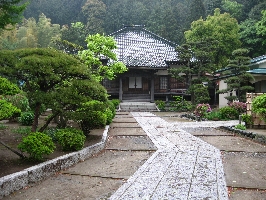
Full name: Kikyozan (亀鏡山) Daichoji
Denomination: Jodo sect (浄土宗)
Location: To reach Daichoji Temple you must walk along the prefectural road in front of Kamakura Joshi Daigaku (鎌倉女子大学), Kamakura Women's College, some 400 meters toward Kita-Kamakura. From there, you will see a lane leading off to the left. At its end is Daichoji.
History: The temple was founded in 1546 by Hojo Tsunashige (北条綱成, 1515-87), the adopted son of Hojo Ujitsuna (北条氏綱, 1486-1541), the second castle lord of Odawara, both in memory of the daughter of Ujitsuna and in the hope of the well-being of the people when Tsunashige was the chief of Tamanawa Castle (玉縄城).
The founding priest was Kan'yo Sontei (感誉存貞). The fourth chief priest, Genei (源栄), was so virtuous and widely known that even Tokugawa Ieyasu (徳川家康, 1542-1616) visited him here at the temple.
Grounds: After you pass through the temple gate, you will see stone Buddhist statues and stone stupas neatly arranged on both sides of the approach to the Main Hall. This hall houses an Amida- sanzon (阿弥陀三尊), a triad of Amida Nyorai (阿弥陀如来) and two bodhisattvas, Kannon Bosatsu (観音菩薩) and Seishi Bosatsu (勢至菩薩).
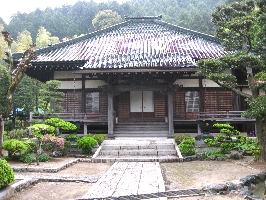
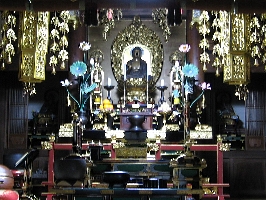
To the right are statues of Zendo (善導, 613-681), a Chinese priest, and Honen (法然, 1133-1212), and to the left is a statue of Ujitsuna's wife. This statue is valuable because both the carver's name, Sotaku (宗琢) and the time of carving, the Muromachi period (1336-1573), are identified.
Treasure Hall within the upper courtyard holds a statue of Tokugawa Ieyasu along with mortuary tablets of himself and his father, Matsudaira Hirotada (松平広忠, 1526-1549). Other treasures in the Hall are: a painting of Kurikara Ryuo (倶梨伽羅龍王), a kind of dragon king said to be the incarnation of a sword, chiken (智剣), carried by Fudo Myoo (不動明王) (donated by Ujiyasu); a painting called the Yamagoe Amida Zu (山越阿弥陀図), "Mountain-crossing Amida"; a Declaration of Sincerity, kishomon (起請文); an old spear, and some old documents.
Within the grounds are two wells, one called Kisshosui (吉祥水) and the other Ume no I Well (梅の井), both of which are said to produce water of fine quality. A bell cast in 1819 hangs in the belfry. In the cemetery are the tombs of Ujitsuna's wife, who died in 1558, and family members of the Hojo (北条) in Odawara.
| Sainenji Temple (西念寺) |
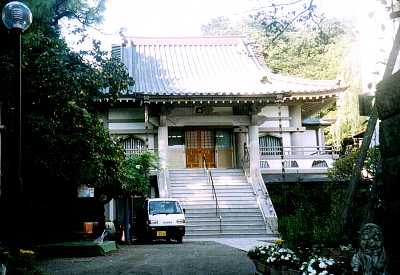
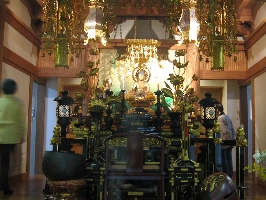
Full name: Ganraizan (岩瀬山) Sainenji
Denomination: Jodo sect (浄土宗)
Location: The temple is approximately 500 meters from Daichoji Temple in the direction of Imaizumi.
History: The temple was founded some time between 1532 and 1555.
Grounds: In the Main Hall are statues of Amida Nyorai, Zendo, and Honen. The cave behind the Main Hall is said to have been used by the founding priest, Un'yo Kodo (運 誉光道) for training, but was originally a horizontal cave tomb.
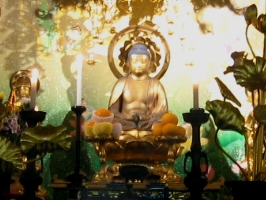
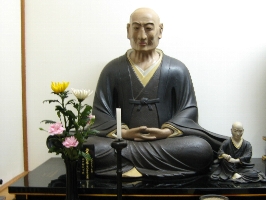
The temple also holds statues of a husband and wife named Kiya (木屋). The two lived in Edo, and wanted to leave realistic statues of themselves.
| Hakusan Jinja Shrine (白山神社) and Bishamondo Hall (毘沙門堂) |
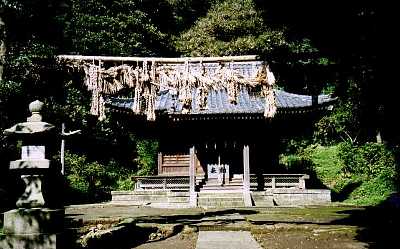
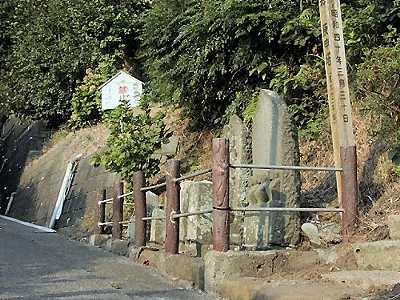
Location: One access to Hakusan Jinja Shrine is to take a bus from Ofuna Station and get off at Hakusan Jinja Mae Bus Stop (白山神社前). A 100-meter walk from there will bring you to the shrine on a hillside to the left.
Grounds: At the beginning of the approach you will see a stone lantern, and a stone monument which bears a kyoka (狂歌), a comic tanka (短歌), composed by Suikitei Ame no Hiromaru (酔亀亭天広丸), who was born in this area in the Edo period (1603-1867).
On the way to the Main Hall you will notice a koshinto-type (庚申塔) stone monument, which has carvings in relief of three monkeys and is inscribed with an era name 寛文十二年 (corresponding to 1672), and a Bato Kannon (馬頭観音) monument among eight stone monuments.
A little further Is another stone monument bearing the characters "毘沙門," Bishamon.
At the top of the steep stairway is the Main Hall of the shrine under a tall ginkgo tree.
The shrine is the tutelary deity of the Imaizumi area and is dedicated to Kukuri Hime no Mikoto (菊理姫之命).
In front of the hall, a long and thick straw rope in the shape of a large "creature" can be seen hung between two trees. It represents a huge centipede, which is said to also be the guardian deity that features in the Oshimesai Festival (大注連祭) held on the first Sunday in September.
Another hall in the grounds is a Bishamondo (毘沙門堂), which dates back to the Heian period (794-1185/92). Inside is a statue of Bishamonten, also called Tamonten (多聞天), which is open to the public during the shrine's festival in September. Bishamonten is one of Shitenno (四天 王, Four Deva Kings), who on guard halfway up the mountain called Shumisen (須弥山), atop which Taishakuten (帝釈天) resides. They are to maintain Buddhist order and to protect those who believe in Buddhism.
There is a story that in 1191, Minamoto no Yoritomo obtained the statue when he visited Kuramadera Temple (鞍馬寺) in Kyoto, and subsequently enshrined it here. The 1.8-meter-high statue was reputedly carved by Gyoki (行基, 668-749) in the Nara period (710-794), but is thought to be an actual work from the late Heian period. In front of the statue is another Bishamonten, made in the Muromachi period (1336-1573), and its attendants: Kisshoten (吉祥天) and Zennishidoji or Zennijidoji (善膩師童子).
Konsenji Temple (今泉寺) to the left of the approach to the shrine is a sub-temple of Kenchoji (建長寺) reconstructed in 1982 and houses, as the main image, a statue of Shutsuzan Shaka or Shussan Shaka (出山釈迦), literally, "Mountain-Leaving Shakyamuni (after his ascetic practices in the mountain)," allegedly the work of Gyoki (行基, 668-749)
| Sanzaigaike Pond (散在ケ池) |
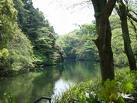
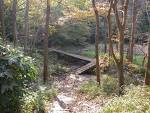
Location: Sanzaigaike Pond can be reached from Imaizumi Fudo Bus Stop (今泉不動).
Grounds: The nearby area is arranged as a park, called Sanzaigaike Shinrin Koen (散在ケ池 森林公園). Cherry blossoms in the spring and maple leaves in the fall, plus a woody land abounding with various kinds of plants attract many people regardless of the season.
In the 1860s, the pond was expanded to serve as a dam for the irrigation of paddy fields in the lower part of the area, but due to housing development and the disappearance of the paddies that function has now ended.
| Shomyoji Temple (称名寺) and Imaizumi Fudo (今泉不動) |

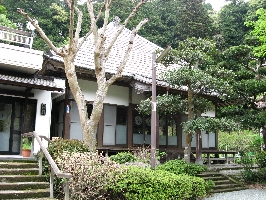
Full name: Konsenzan (今泉山) Shomyoji
Denomination: Jodo sect (浄土宗)
Location: If you take the lane from Imaizumi Fudo Bus Stop toward the hillside and follow it to its end, passing by an incineration factory, Imaizumi Clean Center (今泉クリーンセンター), you will see Shomyoji Temple.
History: Kukai, or Kobo Daishi, was supposedly the founding priest, and the nearby Fudodo Hall (不動堂), closely related to him, is in under this temple. The temple once declined but was restored by Chokuyo Rennyu (直誉蓮入) in the Edo period.
Grounds: The temple grounds are thickly surrounded by trees and seem all the more quiet because of the sound of the nearby waterfalls.
When you pass through the Sammon Gate, you will see an unusual-looking Jizo (地蔵) statue, called Hanataka Jizo (鼻高地蔵), and five other Jizo on the hillside to the left. At the end of the approach are the Main Hall and Kuin (庫院, temple office) to the left.
During the Kamakura period, successive Minamoto (源) shoguns and Hojo (北条) regents visited here for prayer but thereafter the temple was nearly abandoned.
In the early Edo period on a day when Rennyu, a priest, visited Enoshima Island and prayed to Benzaiten (弁才天) there, he was given a divine message that he should offer a prayer to Fudo Myoo in Imaizumi. Rennyu followed this advice and prayed here for seven days in front of Fudo Myoo.
Afterwards, the residents in this area were blessed over the years with abundant harvests. Thus, the local people, thankful for the blessing, had two halls built: one for Fudo Myoo and the other for Amida.
In 1693, the present name, Shomyoji, was created by Teiyo (貞誉), a priest from Zojoji Templein Edo. Since then, the temple has been popular and many people visit here, especially on February 28, when the annual festival is held.


The Main Hall houses images of Amida and twenty-five attending Bosatsu (二十五菩薩), including Kannon Bosatsu and Seishi Bosatsu (Amida's two major attendants). Their configuration is called Shoju Raigo Zo (聖衆来迎像) and is very rare in Kamakura.
They depict Amida's great mercy in which Amida, attended by twenty-five Bosatsu, all on clouds, are descending from the Western Paradise to receive a believer on his deathbed. The work is said to have been made in the Heian period but it has been proved to be a work of the Edo period.
The structure of the inner sanctum and the pillars are elaborately decorated. Next to the Main Hall is Bentendo Hall, in which a statue of Benten is enshrined.

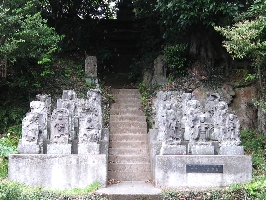
If you climb up the steep stairway behind the Main Hall, you will see a Fudodo Hall (不動堂), which houses a stone statue of Fudo Myoo. This is also called Moto Fudo (元不動) or Imaizumi Fudo. Fudo Myoo, an incarnation of Dainichi Nyorai (大日如来), subdues all kinds of evil and rids people of their worldly desires. On the walls of the hall hang layers of ema (絵馬), votive tablets.
To the right of the Main Hall you will see a line of stone images: the one in the center is Dainichi Nyorai, the others are Sanjuroku-doji (三十六童子), literally, Thirty-six Children, who are presumed to be young monks in apprenticeship or young attendants to Bosatsu.
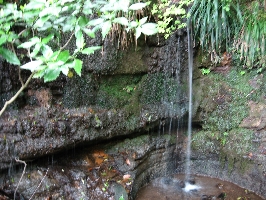
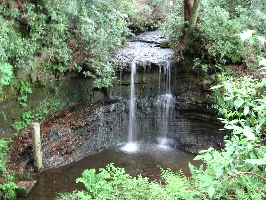
By retracing your steps, passing Bentendo Hall, and going down more stone steps, you will reach a pair of waterfalls: the three-meter-high Otaki (男滝), literally, "Male Waterfall," and the 1.2-meter-high Metaki (女滝), "Female Waterfall." They were, tradition says, created by Kobo Daishi when he dug two recesses in the cliff to provide water for local people in need.
Area: Ofuna (大船) and Takano (高野)
Place Name
The name of the area, Ofuna, is said to be a corruption of "Awafune", part of the name of a mountain, Awafuneyama (粟船山) behind Jorakuji Temple (常楽寺). The "awa (粟)" in Awafune means millet and the "fune (船)" means a ship. In olden days, when parts of the area were under water and inlets were here and there, ships laden with millet grain frequented here.After the sea receded, a mountain appeared and it came to be called Awafuneyama Mountain in connection with "awa" and "fune." Until the mid-Edo period (1603-1867), Ofuna was written 粟船 or 青船.
| Jorakuji Temple(常楽寺) |
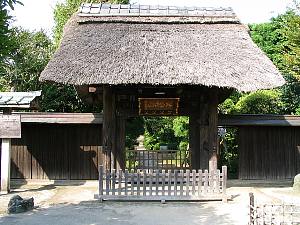
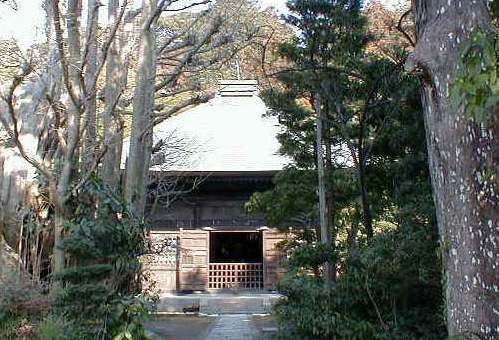
Full name: Zokusensan (粟船山) Jorakuji
Denomination: Rinzai Zen sect (臨済宗)
Location: To visit Jorakuji Temple, take a bus from Ofuna Station and get off at Hanareyama (離山) Bus Stop. Pass Ofuna Junior High School (大船中学校) on your right and continue some 50 meters, and you will see the temple on the left.
History: Hojo Yasutoki had the temple built for the repose of the soul of his mother-in-law, and relocated her grave here from a nearby area.
At the start, the temple was named Awafunemido (粟船御堂) and the opening ceremony was presided over by Taiko Gyoyu (退耕行勇, 1163-1241).
Yasutoki was also buried here, in 1242, and the temple name was changed to Jorakuji after his posthumous name, Jorakuin (常楽院).
Four years later in 1246, Rankei Doryu came here from Jufukuji Temple (寿福寺) at the request of Hojo Tokiyori (北條時頼, 1227-63), the fifth regent, and opened a training center for Zen meditation. Doryu resided here until Kenchoji Temple (建長寺) was completed in 1253.
From that time on, because of this connection, the temple was highly thought of by the priests of Kenchoji. However, in time, the temple was reduced to only Butsuden Hall (仏殿) and Monjudo Hall (文殊堂) through a series of disasters.
Grounds: On the left-hand side of the pathway to the temple stands a stone monument with the inscription 木曾義高 北条泰時公墓, Tombs for Kiso Yoshitaka (木曾義高, 1173-1184) and Hojo Yasutoki (北条泰時, 1183-1242). The latter was the third regent of the Kamakura bakufu (鎌倉幕府) and the founding patron of the temple.
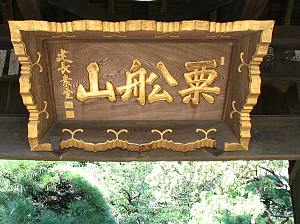
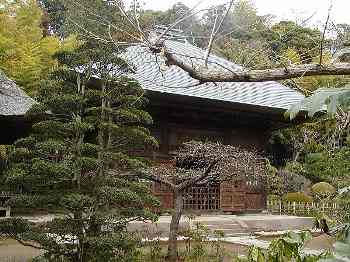
If you continue north along the lane lined with pine trees, a thatched Sammon Gate (山門) will come into sight. The plaque on the beam of the gate bears the characters 粟船山, the sango of the temple, which, in this case, must be read "zokusensan," not "awafuneyama," and are in the handwriting of Mokuan Seito (木菴性とう) made in 1688.
After you pass through the gate, you will see the priests' living quarters to the right, and the Main Hall next to it in quiet grounds surrounded by trees. The Main Hall houses a number of Buddhist images: Shaka Nyorai (釈迦如来), Rankei Doryu (蘭渓道隆, 1213-78), a.k.a. Daikaku Zenji (大覚禅師), and Otogodoji (乙護童子), a deity in the form of a child who protects Buddhism and takes care of ascetics.
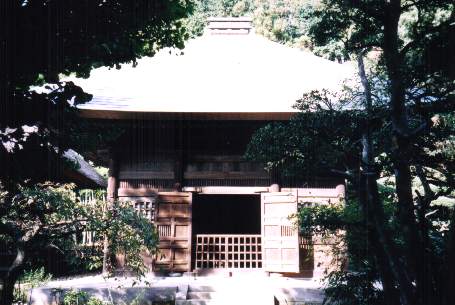
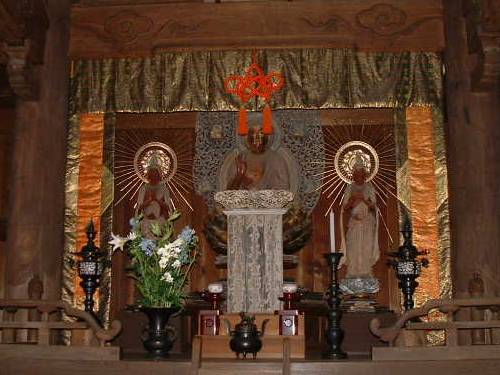
When you pass by an old ginkgo tree, reportedly planted by Yasutoki himself, you will soon be in front of Butsuden Hall, rebuilt in 1988, and designated an Important Cultural Property by Kanagawa Prefecture.
Inside is an image of Amida Nyorai (阿弥陀如来) in the center, flanked by Kannon Bosatsu (観音菩薩) and Seishi Bosatsu (勢至菩薩). To their right stands an image of Rankei Doryu made in the Muromachi period (1336-1573).
On the ceiling is a picture of a dragon in clouds called Unryu (雲龍) by Kano Yukinobu (狩野雪信, a.k.a. Kiyohara Yukinobu, a woman painter in the early Edo period), unusual in that its eyes were painted closed, supposedly to keep it from moving around, because the dragon, it is said, made a roaring sound when it went out to drink water.
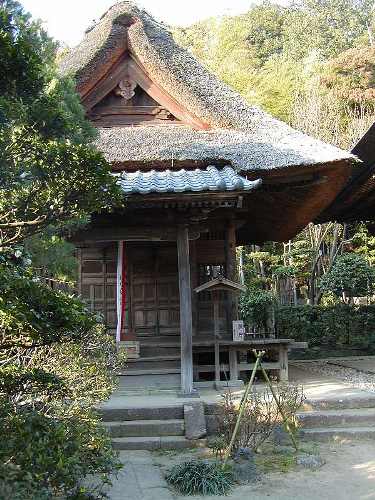 Next to Butsuden
Hall is Monjudo Hall (文殊堂). It was transferred from the grounds of Eishoji
Temple (英勝寺) in Ogigayatsu (扇ガ谷) in the early Meiji Period (1867-1912),
and it houses an image of Monju, allegedly brought from China by Rankei
Doryu, and images of Fudo Myoo (不動明王) and Bishamonten
(毘沙門天).
Next to Butsuden
Hall is Monjudo Hall (文殊堂). It was transferred from the grounds of Eishoji
Temple (英勝寺) in Ogigayatsu (扇ガ谷) in the early Meiji Period (1867-1912),
and it houses an image of Monju, allegedly brought from China by Rankei
Doryu, and images of Fudo Myoo (不動明王) and Bishamonten
(毘沙門天).The Monju image (made in the late Kamakura period (1185/92-1333) and designated an Important Cultural Property by Kanagawa Prefecture) is popular because it gives wisdom to all the faithful. It is opened to the public on January 25, when the Monju Festival is held.
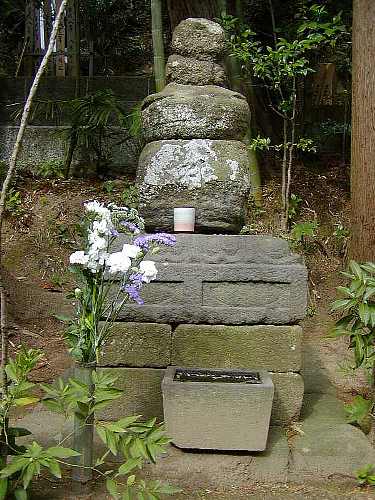 In the graveyard behind the halls are tombs for a
number of celebrated people. In the center is the tomb of Ryuen (竜淵), a
priest, who restored the temple in the mid-nineteenth century, and to the
right the tomb of Hojo Yasutoki, then one for Daio Kokushi (大応国師, also
called Nampo Jomin, 南浦紹明, fourteenth century).
In the graveyard behind the halls are tombs for a
number of celebrated people. In the center is the tomb of Ryuen (竜淵), a
priest, who restored the temple in the mid-nineteenth century, and to the
right the tomb of Hojo Yasutoki, then one for Daio Kokushi (大応国師, also
called Nampo Jomin, 南浦紹明, fourteenth century).
The temple has the oldest bronze bell in Kamakura, with the era name 宝治ニ年(corresponding to 1248)and is designated an Important Cultural Property.
It was made in memory of Yasutoki by Tokiyori, Yasutoki's great grandson. Because of its workmanship, the bell is counted among the three most celebrated bells in Kamakura, the others being at Kenchoji and Engakuji (円覚寺). It is now on loan to Kamakura Kokuhokan (鎌倉国宝館), where it is on display. Though not as massive as the others it is well-balanced, and bears the characters 寺号常楽 (jigo Joraku).
Story: Hojo Yasutoki, the founder of the temple, was born in 1183 as the first son of Hojo Yoshitoki (北條義時, 1163-1224), the second regent. Yasutoki made the first law for warriors, Goseibai Shikimoku (御成敗式目, also called Joei Shikimoku, 貞永式目) in 1232.
The basic principles for the law were based on the customs and practices formed from the time of Minamoto no Yoritomo (源頼朝, 1147-99). It clarified the rights and duties among warriors, established the basic grounds for administering the affairs of state and justice, and became the model for other warrior laws.
Though Yasutoki was regent, he led a simple life, and was trusted by his men. He died at the age of sixty after building up the political system and reinforcing the authority of the government.
Shikiten-Munetsuchi Pond (色天無熱池)
The pond to the right of the Main Hall is called Shikiten-Munetsu-chi. "Shikiten" is the name of the second of the Three Worlds: the first of which is The World of Desire, in which inhabitants have both appetite and sexual desire; the second The World of Form, in which they have neither appetite nor sexual desire; and the third The Formless World, in which inhabitants have no physical form."Munetsu-chi" is the pond where Anokuda Ryuo (阿縟達龍王), the most virtuous King, resides, and is a comfortable place without the scorching flames that would otherwise torture the damned. Be that as it may, this pond is an ideal place for reflecting on what it means to be living in a world full of appetites and earthly desires.
The Tomb of Kiso Yoshitaka (木曾義高の墓)
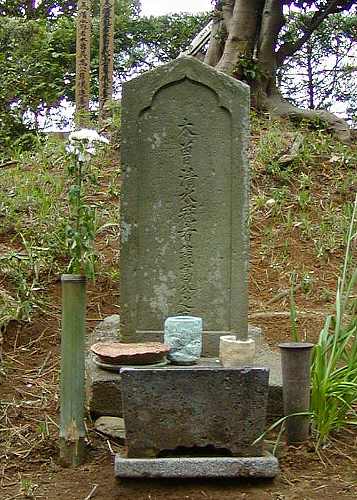 Atop Mt. Awafune behind Jorakuji Temple is a
mound and a stone monument surrounded by cherry trees. The mound is for
Kiso Yoshitaka, the eldest son of Minamoto no Yoshinaka (or, popularly,
Kiso Yoshinaka, 木曾義仲, 1154-84). There is a sad story behind the reason he
was buried here in such a lonesome place.
Atop Mt. Awafune behind Jorakuji Temple is a
mound and a stone monument surrounded by cherry trees. The mound is for
Kiso Yoshitaka, the eldest son of Minamoto no Yoshinaka (or, popularly,
Kiso Yoshinaka, 木曾義仲, 1154-84). There is a sad story behind the reason he
was buried here in such a lonesome place.Kiso Yoshinaka was a cousin of Minamoto no Yoritomo, and when Yoshinaka rose up against the Taira, he sent his son to Yoritomo to show his loyalty. Yoshitaka (1173-84) then became the betrothed of Yoritomo's eldest daughter, Ohime (大姫, 1179?-97), although in truth Yoshitaka was virtually a hostage.
Later, when Yoshinaka and Yoritomo came to vie for power, Yoshinaka was defeated and killed in 1184. Thereafter, Yoritomo waited for an opportunity to kill Yoshitaka. When Ohime discovered this, she pleaded with her father, Yoritomo, not to carry out his intention, but to no avail. Ohime's mother, Masako (政子, 1157-1225), tried to thwart Yoritomo by letting Yoshitaka flee disguised as a girl.
This, however, gave Yoritomo the excuse he needed to put his scheme into practice, and Yoshitaka was killed on the riverbed of the Irumagawa River (入間川). It was in the same year when his father was defeated and killed. He was first buried in a rice field nearby, but relocated here in 1680 by a local villager.
| Tamon'in(多聞院) |
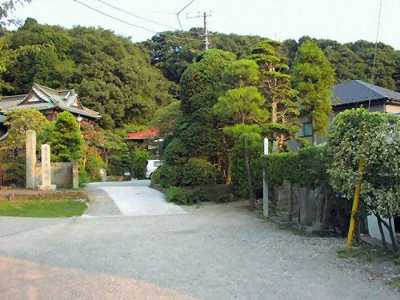
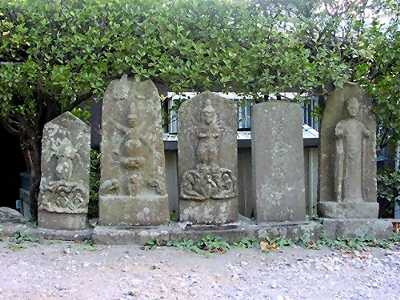
Full name: Ten'eisan (天衛山) Tamon'in
Denomination: Shingon sect (真言宗)
Location: To reach Tamon'in, walk east along the road in front of Jorakuji Temple to the crossroad equipped with traffic lights. Cross there and continue some 400 meters walking among houses, and you will see the temple, which is popularly known as Togenuki Jizo (とげぬき地蔵), literally, "Splinter-Pulling Jizo."
History: The temple was found between 1469-87 by the Amakasu clan (甘粕氏) by inviting priest Nankai sozu (南介僧都).
Grounds: Around the temple gate are some koshin-to type (庚申塔) stone monuments. In the Main Hall are images of Bishamonten and Eleven-faced Kannon, or Juichimen Kannon (十一面観音).
Among the treasures the temple possesses are decrees issued by three cloistered Emperors: one is by Go-Shirakawa-in (後白河院, 1127-92) in 1183, another is by Go-Saga-in (後嵯峨院, 1220-72) in 1250, and the other is by Kogon-in (光厳院, 1313-64) in 1346.
Another treasure is a lacquered bowl with a high foot, which bears the era name 天正九年 (corresponding to 1581), but which is now on loan to Kamakura Kokuhokan.
| Kumano Jinja Shrine (熊野神社) |
In the Main Hall is a wooden statue in a type of formal wear called sokutai (束帯), a ceremonial court dress worn by an emperor and court officials (typically in the Heian period: 794-1185/92). Next to the Main Hall is Haiden Hall, Worship Hall, which is also called Kaguraden (神楽殿) because it functions as a hall for kagura (神楽), sacred dancing.
| Rokkokukenzan (六国見山) |
At the top of the mountain is a mound called Fujizuka (富士塚). Some large and small stone monuments mark this area as the site of a religious rite with regard to Mt. Fuji. As Mt. Fuji was considered from ancient times to be sacred, climbing it started as a religious practice. In the Edo period, the practice became popular and even religious circles, called Fujiko (富士講), were organized among the people. Places where Mt. Fuji could be clearly viewed also came to be regarded as sacred and monuments were built.
| Kita-Kamakura Art Museum (北鎌倉美術館) |